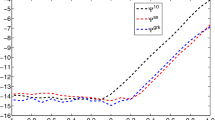Abstract
A new algorithm is developed for long-term integrations of the N-body problem. The method uses symplectic integrations of the Hamiltonian equations of motion for each body. This allows one to employ individual adaptive time-steps in computations. The efficiency of this technique is demonstrated by several tests performed for typical problems of Solar System dynamics.
Similar content being viewed by others
References
Aarseth S. (2003). Gravitational N-Body Simulations. Tools and Algorithms. Cambridge monographs on Mathematical Physics. Cambridge University Press, Cambridge
Brouwer D. and Woerkom A.J.J. (1950). The secular variations of the orbital elements of the principal planets. Astron. Pap., Washington 13: 85–107
Chambers J.E. (1999). A hybrid symplectic integrator that permits close encounters between massive bodies. Mon. Not. Roy. Astron. Soc. 304: 793–799
Duncan M.J., Levison H.F. and Lee M.H. (1998). A multiple time step symplectic algorithm for integrating close encounters. Astron. J. 116: 2067–2077
Emel’yanenko V.V. (2002). An explicit symplectic integrator for cometary orbits. Celest. Mech. Dyn. Astron. 84: 331–341
Fukushima T. (2003). Efficient orbit integration by scaling for Kepler energy consistency. Astron. J. 126: 1097–1111
Gladman B., Duncan M. and Candy J. (1991). Symplectic integrators for long-term integrations in Celestial Mechanics. Celest. Mech. Dyn. Astron. 52: 221–240
Hairer E. and Söderlind G. (2005). Explicit, time reversible, adaptive step size control. SIAM J. Sci. Comput. 26: 1838–1851
Lee M.H., Duncan M.J. and Levison H.F. (1997). Variable timestep integrators for long-term orbital integrations. In: Clarke, D.A. and West, M.J. (eds) Proc. 12th Kingston Meeting, Computational Astrophysics., pp 32–38. Astronomical Society of the Pacific, San Francisco
Mikkola S. (1997). Practical symplectic methods with time transformation for the few-body problem. Celest. Mech. Dyn. Astron. 67: 145–165
Mikkola S. and Aarseth S. (2002). A time-transformed leapfrog scheme. Celest. Mech. Dyn. Astron. 84: 343–354
Mikkola S. and Innanen K. (2002). Individual accuracy checks for massive bodies and particles in symplectic integration. Astron. J. 124: 3445–3448
Mikkola S. and Tanikawa K. (1999). Explicit symplectic algorithms for time-transformed Hamiltonians. Celest. Mech. Dyn. Astron. 74: 287–295
Mikkola S. and Wiegert P. (2002). Regularizing time transformations in symplectic and composite integration. Celest. Mech. Dyn. Astron. 82: 375–390
Preto M. and Tremaine S. (1999). A class of symplectic integrators with adaptive timestep for separable Hamiltonian systems. Astron. J. 118: 2532–2541
Rauch K.P. and Holman M. (1999). Dynamical chaos in the Wisdom–Holman integrator: origins and solutions. Astron. J. 117: 1087–1102
Saha P. and Tremaine S. (1992). Symplectic integrators for Solar System dynamics. Astron. J. 104: 1633–1640
Saha P. and Tremaine S. (1994). Long-term planetary integration with individual time steps. Astron. J. 108: 1962–1969
Sanz-Serna J.M. and Calvo M.P. (1994). Numerical Hamiltonian Problems. Chapman & Hall, London
Sharaf Sh.G. and Budnikova N.A. (1967). On the secular changes of the orbital elements of the Earth influencing a climate of the geological past. Bull. Inst. Theor. Astron. Akad. Nauk SSSR 11: 231–261
Stiefel E.L. and Scheifele G. (1971). Linear and Regular Celestial Mechanics. Springer-Verlag, Berlin, Heidelberg, New York
Szebehely V. (1967). Theory of Orbits. Academic Press, New York
Wisdom J. and Holman M. (1991). Symplectic maps for the N-body problem. Astron. J. 102: 1528–1538
Wisdom J., Holman M. and Touma J. (1996). Symplectic correctors. Fields Inst. Commun. 10: 217–244
Yoshida H. (1990). Construction of higher order symplectic integrators. Phys. Lett. A 150: 262–268
Author information
Authors and Affiliations
Corresponding author
Rights and permissions
About this article
Cite this article
Emel’yanenko, V.V. A method of symplectic integrations with adaptive time-steps for individual Hamiltonians in the planetary N-body problem. Celestial Mech Dyn Astr 98, 191–202 (2007). https://doi.org/10.1007/s10569-007-9077-6
Received:
Revised:
Accepted:
Published:
Issue Date:
DOI: https://doi.org/10.1007/s10569-007-9077-6



